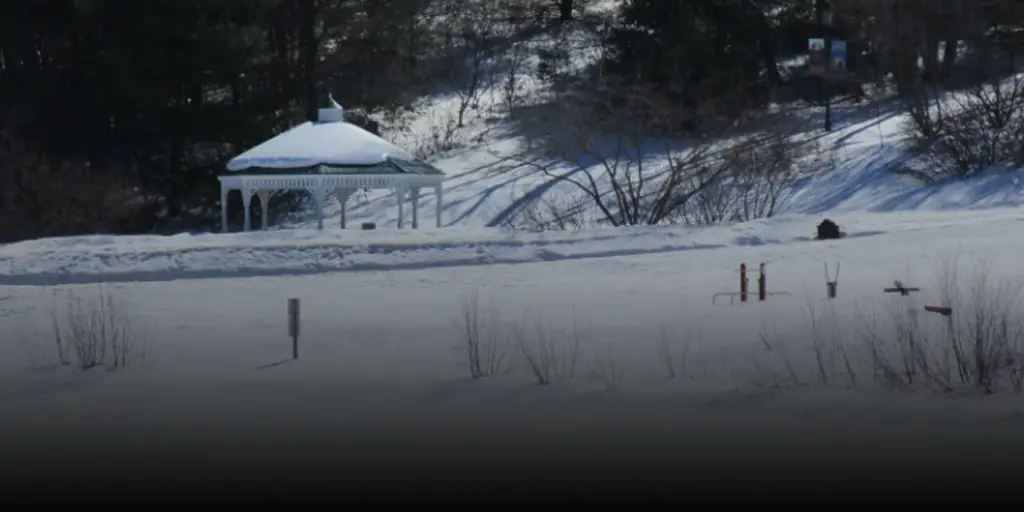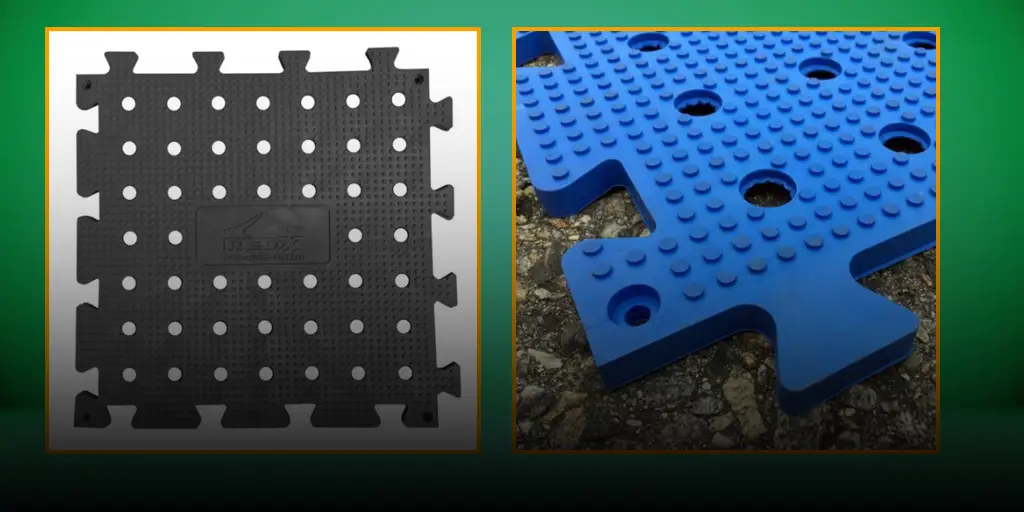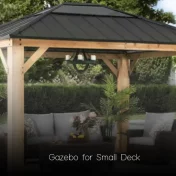For many, gazebos are synonymous with the sun-soaked days of summer – a retreat from the harsh glare of the sun, a cool spot to enjoy the outdoors.
However, as the frosty grip of winter takes hold, gazebos are often left abandoned, a reminder of warmer, brighter days. But what if you could transform your gazebo into a cozy haven, even in the heart of winter?

In this comprehensive guide, we unravel the secrets of how to heat a gazebo in winter, turning it from a seasonal structure to a year-round sanctuary.
Winter brings with it a unique charm and serenity. The world, blanketed in snow, takes on a magical allure, an ethereal beauty. Imagine sipping on a hot cup of cocoa, the world around you painted white, from the cozy confines of your warm gazebo.
The crackling of the fire pit, the gentle rustling of the bare trees, a gazebo in winter isn’t just possible – it’s a luxurious retreat awaiting your presence.
In the following sections, we dive deep into the various aspects of making this dreamy winter gazebo a reality.
From selecting the right type of gazebo for winter use, exploring the myriad of heating options available, to addressing common safety concerns, every nugget of information you need to transform your chilly gazebo into a warm winter retreat is neatly packed in this guide.
You will uncover:
- Benefits: Why should you consider utilizing your gazebo in winter?
- Selection Tips: How to choose a gazebo that withstands the harsh winter elements?
- Heating Methods: What are the most effective and safe ways to heat your gazebo?
- Common Questions: Addressing your safety and functionality concerns.
- Real-life Examples: A case study unveiling the magic of a well-heated gazebo.
- Product Recommendations: A curated list of top products to warm your gazebo.
So, buckle up as we embark on this exciting journey to defy the icy clutches of winter and breathe warmth and life into your beloved gazebo!
Benefits of Utilizing Gazebos in Winter
In the still, crisp air of winter, where nature adorns a minimalistic attire and the landscape is painted with hues of whites and grays, a warm and cozy gazebo emerges as an oasis of comfort.
Many are yet to discover the untapped potential of gazebos during the colder months, a secret space that combines the silent beauty of winter with the comfort of warmth. Here, we unfold the manifold benefits that await when you explore how to heat a gazebo in winter.
Enhanced Aesthetic Appeal
A gazebo adorned with soft glows of lights, set against the backdrop of a tranquil winter landscape, is a sight to behold. It adds a touch of elegance and allure to your outdoor space.
Imagine the sparkling snow, the bare, artistic outlines of trees, and in the midst, your gazebo, a sanctuary of warmth and light.
Versatile Usage
From being a tranquil retreat for family gatherings to transforming into a hub for winter barbecues, the usage of a gazebo is only limited by imagination.
It can also be a serene space for meditation and relaxation, where the silent beauty of winter complements the internal journey of calm.
- Family Gatherings: A cozy space for family to unite, share stories, and create memories.
- Winter Barbecues: Turn the chilly evenings into a culinary fiesta with grills and laughter.
- Meditation Space: The tranquility of winter enhances the peace and calm within.
Boosted Property Value
A well-maintained gazebo that is usable year-round is a valuable addition to your property. It speaks of luxury, comfort, and an aesthetic taste, making your property appealing to potential buyers. It’s not just a structure; it’s a lifestyle statement.
Health and Well-being
During the colder months, when the indoors become our refuge, a heated gazebo offers the rare privilege of enjoying the outdoors without the accompanying chill.
It’s a space where the freshness of the outdoor air meets the comfort of warmth, promoting mental and physical well-being.
- Mental Health: The change of scenery, the embrace of nature, it all uplifts the spirit.
- Physical Health: It encourages spending time outdoors, promoting physical activity and reducing the lethargy associated with winter.
Economic Events and Social Gatherings
For event planners and business owners, a warm gazebo is a pathway to host events even during the off-season.
It’s an economic advantage, a means to extend business operations and social gatherings without waiting for the mercies of weather.
In essence, heating a gazebo during the winter months is not just about combating the cold.
It’s about unveiling a world of opportunities, a space that defies the restrictions of seasons, and a sanctuary that harmoniously blends the silent, ethereal beauty of winter with the tangible, cozy warmth of heat.
“A winter gazebo is not a luxury, but an untapped asset, a space of warmth set amidst the tranquil chill, where every moment spent is a dance between the external cold and internal warmth.”
Selecting the Right Gazebo for Winter Use
The journey to having a warm, inviting gazebo during winter commences with the selection of an appropriate structure that is adept at handling the nuances of colder months.
A winter-ready gazebo isn’t just a luxury, but a crafted piece of art engineered to offer comfort amidst the chill. Let’s unfurl the elements to consider, ensuring your gazebo isn’t just a summer spectacle but a winter wonder.
Material and Build Quality
Material Quality: The primary material of the gazebo determines its resilience. Opt for materials that are resistant to rust, decay, and are adept at withstanding the snow and icy winds.
- Metal: Sturdy, durable but requires anti-rust coatings.
- Wood: Offers natural insulation but demands regular maintenance.
- Vinyl: Low maintenance and decent durability.
Build Quality: A gazebo that creaks at the mercy of winds is no companion for winter. Seek structures with sturdy build, reinforced joints and foundations that kiss the earth with grace and firmness.
Side Panels and Insulation
Side Panels: The incorporation of side panels isn’t a choice but a necessity for winter gazebos. They shield against icy winds, ensure heat retention and offer privacy.
- Enclosed Panels: Offer maximum insulation, though ensure they are equipped with ventilation options to balance the air circulation.
- Semi-Enclosed Panels: A blend of exposure and enclosure, suitable for milder winters.
Insulation: Consider gazebos that have additional insulation options, ensuring that the warmth isn’t a fleeting guest but a constant companion.
Durability Against Winter Elements
Weather Resistance: Every gazebo can bask under the sun, but it takes a well-crafted one to dance in the snow. Seek gazebos labeled as ‘all-weather’, ‘weather-resistant’ or those with specific ratings for snow and wind resistance.
Maintenance Needs: Winter brings along not just the cold, but also the demand for maintenance. Opt for gazebos that demand minimal upkeep during these months for a hassle-free experience.
Aesthetic and Functional Balance
While the functional attributes are non-negotiable, let’s not sideline the aesthetics. A winter gazebo should be a blend of warmth and beauty, a sight that compliments the serene, tranquil winter landscapes.
- Design: Seek designs that are not just functional but also aesthetically pleasing. Let the gazebo be a visual treat, adorned with the potential for decorations and lighting.
- Space: Ensure the gazebo offers ample space, not just to host people but also heating elements, furniture, and decorations without congestion.
Gazebo Material Comparison
| Material | Pros | Cons |
|---|---|---|
| Metal | Durable, sturdy, can be weather-resistant with appropriate coatings | Can rust, may conduct cold, needs maintenance |
| Wood | Natural insulation, aesthetic appeal | Demands regular maintenance, can be expensive |
| Vinyl | Low maintenance, decent durability | May not be as sturdy as wood or metal |
In essence, selecting the right gazebo for winter is a meticulous balance between the rugged demands of durability and the subtle touch of aesthetics.
It should be a structure that stands as a testament to warmth amidst the cold, a sanctuary where the chill is a viewed spectacle, not a felt experience.
“Choosing the right gazebo for winter is akin to selecting a companion for the cold – it should not just withstand the chill but transform it into a warm embrace.”
Effective Methods to Heat a Gazebo
Winter gazebos are ethereal spaces where the stark, silent beauty of cold landscapes can be admired from the comforting embrace of warmth.
To transform your gazebo into such a haven, integrating efficient heating methods is crucial. In this section, we explore the myriad of options available, guiding you on the pathway of how to heat a gazebo in winter with efficacy and safety.
Gazebo Heaters
Gazebo heaters are the frontline warriors in banishing the cold, transforming the icy air into a warm embrace. But not all heaters are born equal, and the choice hinges upon various factors.
- Electric Heaters: These are popular for their ease of use and installation. They’re efficient and safe, devoid of the risks associated with open flames or fuel storage.
- 3-Way HALOGEN Instant Shelter Heater: Renowned for its efficiency, it converts 95% of input energy into instant, odor-free heat. It’s a symphony of practicality and performance.
- Hanging Patio Heaters: Though aesthetically pleasing, their efficiency isn’t on par with their halogen counterparts.
- Gas Heaters: These can be powerful and provide instant warmth, but they come with their set of safety considerations, especially regarding ventilation and fuel storage.
Comparing Heater Types
| Type | Efficiency | Installation | Safety | Aesthetics |
|---|---|---|---|---|
| Electric | High | Easy | Very Safe | Modern Look |
| Gas | Variable | Moderate | Safety Considerations | Classic Appeal |
Flooring
The ground, kissed by winter, becomes a conductor of cold. To arrest this icy intrusion, the right flooring is paramount.
- PROTEX Recycled Floor Tiles: Environmentally friendly, these tiles not only resist the cold but also offer a touch of aesthetics to the gazebo. Easy to install, they are a harmonious blend of form and function.
- Carpeting and Rugs: Though not as effective as specialized floor tiles, they add a touch of comfort and aesthetics, making the gazebo feel homelier.
Making the Gazebo Cozy
Beyond the technicalities of heating, there lies an art of transforming the gazebo into a cozy retreat, where every element sings the song of warmth.
- Duvets and Blankets: Wrap your gazebo in the soft embrace of duvets and blankets. They are not just functional but also aesthetic, transforming the space into a visual and sensory retreat.
- Cushions: A gazebo adorned with cushions is a gazebo that invites relaxation, conversation, and moments of silent reflection amidst the cold.
- Lights: The soft glow of lights isn’t just illuminating; it’s warming. Choose lights that not only dispel the darkness but add a touch of warmth.
Safety Considerations
Every method of heating comes adorned with a robe of responsibility. Safety isn’t a choice but a mandate.
- Ventilation: Especially critical for gas heaters, ensure the gazebo is well-ventilated to prevent the buildup of fumes.
- Distance from Flammable Materials: Whether it’s electric heaters or other forms, maintaining a safe distance from flammable materials is non-negotiable.
- Installation and Usage Guidelines: Adherence to the installation and usage guidelines isn’t bureaucratic compliance but a pathway to safety and efficiency.
“In the silence of winter, a warm gazebo is a sonnet, a poetic embrace where the cold is a witnessed art, not a felt reality.”
In the quest of how to heat a gazebo in winter, the blend of the right heating methods, safety protocols, and the art of coziness unveils a space where winter isn’t a restricting cold, but an aesthetic, silent spectacle to be admired from the warm embrace of your gazebo.
Addressing Common Questions
As we journey into the embrace of a warm, winter-ready gazebo, certain questions, fueled by concerns and curiosities, often surface.
Here, we address these common queries, dispelling myths and illuminating truths, to guide your steps in heating your gazebo safely and efficiently.
Can I Use a Fire Pit or Open Flame in My Gazebo?
This is one of the most common questions, and the answer lies intertwined with safety and practicality.
The inviting crackle of wood, the dance of flames, it’s undeniably alluring. However, safety precedes allure.
- Safety Risks: Open flames present risks of fire hazards. The proximity to the gazebo’s structure, especially if made of wood or other flammable materials, amplifies this risk.
- Ventilation Issues: Enclosed spaces and open flames aren’t the best companions. The risk of smoke accumulation and inadequate ventilation raises concerns.
- Alternatives: Electric and gas heaters emerge as safer alternatives, offering the warmth without the associated risks.
Can Electric Patio Heaters Be Used in a Gazebo?
Yes, they can, with a symphony of caution and care. Electric patio heaters are celebrated for their efficiency, safety, and ease of use.
- Precautions: Ensure they are installed away from flammable materials and the gazebo’s structure. Rain and weather-proof installations are not just advisable but essential.
- Efficiency: They offer the charm of an instant, odor-free heat, transforming the chilly embrace of winter into a warm, inviting atmosphere.
Safety Tips for a Warm Winter Gazebo
Safety isn’t accidental but intentional. Here’s a concise list of safety protocols to adorn your journey of heating your gazebo:
- Installation Expertise: Whether it’s electric heaters or floor insulations, ensure installations are done following the guidelines, preferably by experts.
- Regular Maintenance: A check on the heaters, the electrical connections, and the overall structure ensures that safety isn’t left to chance.
- Fire Extinguisher: A handy companion, especially if you are using heating elements that have even the slightest risk of fire hazards.
- Ventilation: Ensure your enclosed gazebo is well-ventilated, especially if you are using gas heaters, to prevent the accumulation of fumes.
Heater Safety Comparison
| Safety Aspect | Open Flame | Electric Heater | Gas Heater |
|---|---|---|---|
| Fire Hazard | High Risk | Low Risk | Moderate Risk |
| Ventilation | Essential | Not Required | Essential |
| Installation | Complex | Easy | Moderate |
In essence, the journey to a warm, winter gazebo is adorned with questions, and each question, when addressed with knowledge and caution, becomes a step towards a gazebo where winter is an aesthetic spectacle, not a limiting cold.
“In the silent narrative of winter, every question addressed, every safety protocol honored, is a verse that adds to the poetic embrace of a warm gazebo.”
Case Study: A Closer Look at an Efficiently Heated Gazebo
In the frosty embrace of a cold evening, nestled amidst the quiet dance of bare trees, stands Mrs. Smith’s gazebo – a sanctuary where the biting chill of winter is but a picturesque backdrop, never breaching the warm sanctuary within.
How did this transformation occur, turning a once summer retreat into a cozy winter haven? Let’s unravel the story.
The Pre-Transformation Phase
Mrs. Smith’s gazebo was a hive of activity during the summer months but turned into an isolated structure as winter set in.
The chill was an uninvited guest, rendering this outdoor space impractical. Yet, the sight of her gazebo, standing lonely amidst the pristine beauty of winter, sparked a curiosity – could warmth and winter coexist in this space?
The Transformation Journey
A meticulous blend of the right selection, effective heating methods, and safety protocols turned the once chilly gazebo into a warm embrace. Here’s the step-by-step transformation:
Step 1: Right Selection
Mrs. Smith opted for a heavy-duty gazebo with insulated, enclosed panels. The structure, made of rust-resistant metal, stood sturdy, unfazed by the winter winds.
Step 2: Effective Heating
A 3-Way HALOGEN Instant Shelter Heater was the chosen companion. With 95% of the input energy transforming into instant heat, the cold was a distant whisper. The installation was done professionally, ensuring safety and efficiency weren’t compromised.
Step 3: A Cozy Atmosphere
PROTEX recycled floor tiles formed the base, their insulation properties arresting the cold from the ground. The gazebo was adorned with cozy blankets and cushions, and the soft glow of lights added to the warm ambiance.
Step 4: Safety Protocols
With an electric heater in use, all electrical connections were weather-proofed. A fire extinguisher, though never needed, stood as a silent guardian.
The Post-Transformation Phase
Winter evenings turned into a spectacle of silent beauty,observed from the warm embrace of the gazebo. Family gatherings, silent reflections, and even winter barbecues found a home here.
The gazebo wasn’t just a structure but a space where winter was experienced in its silent, pristine beauty, devoid of its biting chill.
Key Takeaways
- Right Selection: A sturdy, insulated gazebo is the foundation of a warm winter outdoor space.
- Effective Heating: The blend of professional installation, efficiency, and safety protocols.
- Cozy Atmosphere: Beyond the technicalities, the art of coziness defines the warmth of space.
- Safety First: Every element of warmth is intertwined with safety protocols, ensuring warmth is a comforting, not alarming, experience.
“In the silent embrace of Mrs. Smith’s gazebo, every winter evening is a story, a narrative where the cold is a witnessed beauty, and warmth, a lived experience.”
With the unraveling of this real-life transformation, the art and science of how to heat a gazebo in winter is no longer a mystery but a pathway adorned with steps of knowledge, choices, and safety protocols.
Products to Consider
Creating a cozy winter haven from your gazebo is about intertwining the art of aesthetics with the science of heating technology.
In this section, we’ll recommend some products that not only boast of efficiency but also elegance, ensuring that your gazebo isn’t just warm but also a visual treat.
1. 3-Way HALOGEN Instant Shelter Heater

- Features:
- 95% energy conversion efficiency.
- Odor-free instant heating.
- Easy and secure attachment to gazebos, shelters, and umbrellas.
- Pros:
- Provides targeted heating, ensuring optimal warmth.
- Energy-efficient, offering warmth without excessive power consumption.
- Cons:
- Requires a power source.
- Not suitable for extremely large gazebos.
2. PROTEX Recycled Floor Tiles

- Features:
- Made from environmentally friendly recycled plastic.
- Easy installation with interlocking design.
- Provides insulation and protection against water and mud.
- Pros:
- Enhances the insulation of the gazebo.
- Easy to clean and maintain.
- Cons:
- Not as aesthetically pleasing as other flooring options.
- May require additional rugs or carpets for enhanced comfort.
3. Weather-Resistant Gazebo Curtains

- Features:
- Made from high-quality weather-resistant materials.
- Enhances privacy and insulation.
- Easy to install and remove.
- Pros:
- Enhances the aesthetic appeal of the gazebo.
- Provides additional insulation.
- Cons:
- Requires regular maintenance.
- Not suitable for gazebos exposed to extreme weather conditions.
Further Reading Recommendations: Best Hardtop Gazebo for Snow Load (Top 5 Picks)
Comparative Table of Featured Products
| Product | Key Feature | Suitable For | Price Range |
|---|---|---|---|
| 3-Way HALOGEN Instant Shelter Heater | 95% energy conversion | Medium-sized gazebos | $$$ |
| PROTEX Recycled Floor Tiles | Eco-friendly insulation | All gazebo types | $$ |
| Weather-Resistant Gazebo Curtains | Enhanced insulation and privacy | Gazebos in mild winter conditions | $$ |
User Reviews Quote
“The 3-Way HALOGEN Instant Shelter Heater transformed my gazebo into a winter retreat. The instant, odor-free heat, combined with its energy efficiency, made every winter evening a cozy affair. It’s not just a product but an experience of warmth amidst the chill.” – John D., a satisfied customer
Wrap Up
Choosing the right products to heat your gazebo is akin to selecting the threads that weave the tapestry of warmth and elegance.
Each product, with its unique features and functionalities, contributes to creating a gazebo where winter’s icy touch is an observed spectacle, not a felt experience.
Every gazebo, when adorned with the right heating products, transcends its structural identity to become a space where winter is a silent, beautiful narrative, and warmth, a tangible, embracing reality.
Preparing Your Gazebo for Winter – A Step by Step Guide
Transforming a gazebo into a cozy winter retreat requires meticulous preparation. Each step, woven with care, ensures that the embrace of warmth is comprehensive and enduring.
Here, we unveil a systematic guide to prepare your gazebo for the winter months, ensuring that every frosty evening is a narrative of comfort and warmth.
1. Assessment and Inspection
Begin with a thorough inspection of the gazebo. Look for any signs of damage or wear and tear. Ensure the structural integrity is uncompromised and ready to withstand the winter’s embrace.
- Check for Damages: Look for any cracks, corrosion, or structural weaknesses.
- Weather Resistance: Ensure the gazebo materials are treated for weather resistance.
2. Installation of Heating Elements
The choice of heating elements is pivotal. Their installation should be meticulous, adhering to safety and operational guidelines.
- Electric Heaters: Ensure they are installed at a safe distance from flammable materials and have weatherproof electrical connections.
- Floor Insulations: Install floor insulations to arrest the cold seeping from the ground.
3. Adding Insulations and Side Panels
Insulating side panels add an extra layer of defense against the cold, ensuring the heat retained is maximized.
- Insulated Panels: Install insulated side panels for enhanced heat retention.
- Weather Stripping: Apply weather stripping to seal any gaps and prevent heat escape.
4. Safety Protocols
Every heating element comes with the responsibility of safety. Ensure all safety protocols are adhered to, making warmth a safe embrace.
- Fire Safety: Have a fire extinguisher accessible. Ensure all heating installations are fire-safe.
- Ventilation: For gas heaters, ensure the gazebo is well-ventilated to prevent fume accumulation.
5. Aesthetic and Comfort Enhancements
Beyond the technical, the art of comfort and aesthetics defines the warmth of a gazebo. Adorn the space with elements that add to the visual and sensory warmth.
- Lighting: Install warm lights that add to the ambiance.
- Furniture: Add cozy furniture that compliments the warm atmosphere.
6. Regular Maintenance
The warmth of a gazebo is sustained with regular maintenance. Ensure all heating elements, insulations, and structural components are in optimal condition.
- Heating Elements: Regularly inspect and maintain to ensure optimal performance.
- Structural Integrity: Periodic checks to ensure the gazebo is ready to withstand the winter’s elements.
Checklist for Winter Gazebo Preparation
- [ ] Structural inspection and repair if needed.
- [ ] Installation of heating elements adhering to safety protocols.
- [ ] Insulation enhancements with side panels and floor insulations.
- [ ] Implementation of safety measures including fire and ventilation safety.
- [ ] Aesthetic and comfort enhancements with lighting and furniture.
- [ ] Scheduled maintenance checks throughout the winter.
“Every step taken to prepare a gazebo for winter is a thread woven into the tapestry of warmth, where each evening is a narrative of comfort, and the cold, a silent, beautiful backdrop.”
With the steps unveiled, the mystery of preparing a gazebo for winter is unraveled, a pathway where warmth is not a visitor but a constant companion.
Conclusion
The silent serenade of winter, with its pristine beauty and frosty embrace, unveils an ethereal narrative. It’s a season where the landscapes, adorned in white, echo a silent sonnet of tranquility.
Yet, amidst this visual spectacle, the biting chill is a constant companion. Here, in this intricate dance of visual serenity and sensory chill, the warmth of a gazebo emerges as a sanctuary, a space where the beauty of winter is a witnessed spectacle, and the chill, an external narrative.
In our comprehensive guide on how to heat a gazebo in winter, every step, choice, and consideration isn’t just informational but transformational.
It’s a pathway where the structural integrity of a gazebo intertwines with the art of heating technologies, safety protocols, and aesthetic adornments, unfolding a space where winter is experienced in its silent beauty, devoid of its restricting cold.
Each gazebo, when adorned with the right heating elements, insulations, and aesthetic touches, transcends its structural identity.
It becomes a narrative, a space where the silent beauty of winter evenings is a canvas of serenity, and warmth, a tangible, embracing reality.



